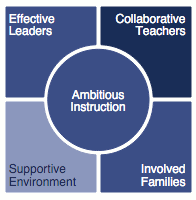Do neighborhood schools make the grade?
West Town schools: Hover over the dots and click for more information.
How would you score neighborhood schools: They strive to reach their full potential? Or, they need improvement? Wells Community Academy, the default high school for East Village teens, could draw either comment.
Rita Raichoudhuri, its principal, will talk Monday with East Village Association members about progress and challenges at Wells and the city's other open-enrollment schools.
She'll be joined by Ernesto Matias, her predecessor as principal, who is working on a bid to launch a citywide language academy. The 7pm meeting is at the Happy Village, 1059 N. Wolcott Ave.
The Illinois School Report Card, issued Friday, gives the school at 936 N. Ashland Ave. high marks for professional development and teacher collaboration. Wells' learning environment is graded on the 5Essentials scale, which the University of Chicago developed to predict student success.
Wells compares well to the Noble Street charter schools, which the state combines in a single report. The state reports do not include religious and private schools.
The state has not yet posted results on the new Partnership for Assessment of Readiness for College and Careers. But Wells lost ground on graduation rate, and its improving results on ACT college-prep exams fall short of the Noble charters.
Raichoudhuri disputes both metrics. The school serves many families that don't stay in one place for four years, but the report card follows Wells' freshman class wherever its pupils land. "It's a fairly strange way to calculate graduation rate," she says. "We graduated 100 percent of our senior class who were physically with us."
Wells is appealing ACT's report, on which national ratings are based: "They have completely different roster counts than we do," the principal says. On U. of C. reports tracking freshman progress, Raichoudhuri argues that Wells has made giant steps, particularly among its large Hispanic cohort.
"I don't even think comparing to charters should be done. I cringe at that," Raichoudhuri says. Even open-enrollment charters can expel students or advise them to transfer to the local schools. "Forget about honors and advanced-placement classes, which they have very few of."
In the state's comparison, Wells shows a lower class size, more advanced-placement programs and more foreign-language offerings than the Noble charters. Wells offers Chinese, French, Japanese and Spanish, which boosts its bid to host a language academy to draw students from beyond local boundaries.
Wells' enrollment has fallen from the State Board of Education count of 617, and now stands at 467. As a result the school faces budget cuts and could be vulnerable in future school closings.
"I'm going to compare just the charters in this area to Wells," the principal says. "None of them have dual-enrollment (college credit) courses, there is no after-school program, they don't have sports, they don't have a theater program – everything that goes into forming a holistic student with a rounded life experience, charters can't offer. There's this focus on academics and discipline alone.
"We hear, 'Parents have choice in Chicago.' But does choice matter if the district is not being transparent about what schools actually offer?"
The state also has posted results for Wells feeder schools Columbus, Mitchell, Otis and Talcott, and local selective enrollment schools LaSalle II and Pritzker.





